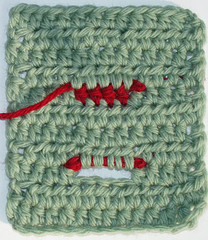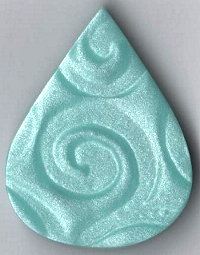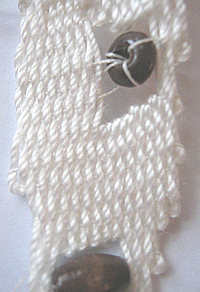I crochet a lot and I’m always making mistakes ;-)
In the case of buttonholes or pocket slots appearing ‘magically’ at the wrong place, I found very valuable hints on what to do.
This is one of the few mistakes I haven’t made yet.
Mostly because I don’t crochet neither buttonholes nor pockets ;-)
Perhaps I should give it a try? ;-))
Polymer Clay Mica Shift
As I saw the wonderful Mica Shift Pendant (which is totally flat!) at craftster.org I felt so inspired.
It is a long time ago that I worked with polymer clay, but I think that I will go back to it soon ;-)
Then I also tried the mica shift technique (links see below), but it didn’t work out satisfactory for any reason.
Perhaps next time? ;-)
Links:
Mica Shift Pendant
Tutorials:
At Polymer Clay Central:
Satin Swirl Egg – Twisted Rope Mica Shift – Texture Sheet Mica Shift
At pcPolyzine Tutorials:
3-D Images – Mica Shift Jellyroll
At Glassattic:
Lots of additional information about Mica effects
Faux Silk
I love to imitate things, so I had to check immediately the tutorial on how to make faux silk for cards.
On the photo you see my results: I took one of my self carved eraser stamps, coloured it with a marker and stamped on tissue paper (the left flower). Then, just to see what happens, I stamped two more times. The photo isn’t so good, but the pale stamps look elegant. On the third I didn’t smooth the paper to allow for more crinkles.
I will use this technique more often.
Links:
Faux Silk
unikatissima’s Eraser Stamps how-to
unikatissima’s Stamping With Markers how-to
Beaded Rings and Headbands
Beading is such a versatile technique and once I found some quick and simple projects: beaded rings and headbands.
The headbands are made in flat netting technique and as daisy chains, the rings are made in brick stitch, which isn’t difficult, too (the site provides links and diagrams who explain/show how to do the different stitches).
I like the flat netting technique, but beaded until now only small glass tubes (see photo).
Links:
Beaded Rings and Headbands (English) (with explaining diagrams)
African Needle Weaving Necklace
Once a found an instruction on how to work an african necklace using needle weaving (also called ‘pin weaving’). It’s a weaving technique that allows to easily create strange shaped fabrics and to incorporate beads into.
Stunning!
I played around with this technique and thought that it could as well be used for little bags, for bracelets and so forth.
Unfortunately it’s a technique that requires a lot patience – which I don’t have. ;-)
I’d love to hear what you think about!
Bicycle Bottle Holder
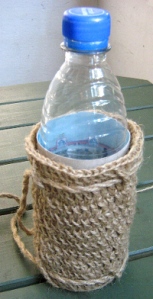
One day my friend asked me, if I have an idea how best to attach his water bottle to his bicycle. I promised him to make him a bottle holder and that’s it: It consists of a cardboard cylinder with bottom and a wrap crocheted from simple package string. I made two cords from the same package string to tie it somewhere to the bicycle.
And that’s how to do it:
- Cut a rectangle from cardboard.
One side must be long enough to go around the bottle plus allowance, the other must be high enough, so that it holds the bottle safely. - If you want the cardboard container to be (quite) waterproof, tape the inside with tape.
Note: I used clear package tape. - Wrap the cardboard around the bottle and wrap with long strips of tape.
Hint: If it has to be waterproof, tape the whole cylinder.
Hint: To make sure, that the cardboard container is not to tight around the bottle, I wrapped the bottle in several layers of old newspapers and wrapped the cardboard around the ‘thickened’ bottle. - Cut a circle from cardboard, optionally tape the to-be inside with tape, too.
- Attach the circle with amply applied package tape to the bottom of your cardboard cylinder.
- Then you can create the outer container.
Note: I crocheted it from package string by first crocheting a circle and then simply working straight up. ‘On the way’ I worked some thread eyes for the cords. The cords themselves were made from the same material.
Hint: It should be easy enough to sew the outer container from a fabric matching your bicycle colours.
The inner cardboard container and the outer crocheted container.
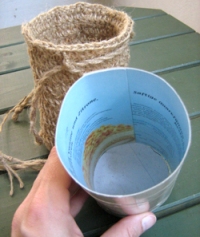
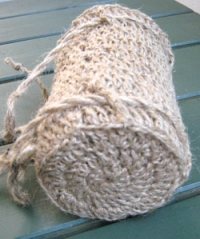
Links:
If a bicycle bottle holder isn’t enough for you, try the Bicycle Handlebar Bag.
Making Any Sized Crochet Circles (English)
Häkeln lernen: Runden und Spiralen (German)
How to make Twisted Cord (English)
Kordel drehen (German)
YoYo Pin
I like yoyo’s, but only recently I tried to make one. And I find it cute.
It is made from shiny polyester fabric and embellished with a little crocheted flower and some embroidered beads (I hate to have polyester on my skin, but I like it for pins and the like, because it is so shiny).
Links:
Yoyo Projects (with explaining pictures)
How to make a Yoyo (with explaining pictures)
The links don’t work anymore, you can find the information here now:
Yoyo Projects (with explaining pictures)
How to make a Yoyo (with explaining pictures)
Polymer Clay Flower Canes
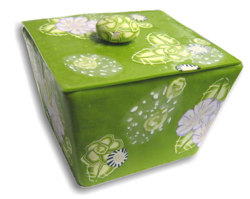
This Thursday started its first challenge which theme is ‘fresh’.
When I heard about I thought immediately about the little polymer clay box I made long ago but am still fond of (not least because of its freshness ;-))
It is a little cardboard box that I covered with polymer clay and embellished with self-made flower and leaf canes (for links to tutorials see links below).
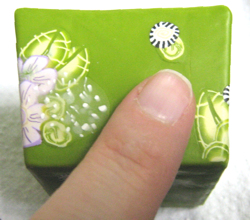 On this picture you see one side of the box. The finger isn’t there by accident, but to show how small the box is ;-))
On this picture you see one side of the box. The finger isn’t there by accident, but to show how small the box is ;-))
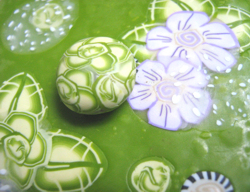 This is a close-up from the lid. You can see the purple Hydrangea-like flowers with the Jellyroll center and the leaves.
This is a close-up from the lid. You can see the purple Hydrangea-like flowers with the Jellyroll center and the leaves.
I made the transparent cane with the white dots to simulate those white flower tufts often used by florists.
 Just a last close-up.
Just a last close-up.
Concerning unikatissima
I’m proud to say that Rosie featured unikatissima yesterday on Inspirational :-))
Links:
Inspirational – Tips, Techniques & Tutorials
Altered (t)art and stuff
Carving Polymer Clay

When working with polymer clay I always found the hints and tips at Glassattic immensely helpful.
They also inspired me to try new things.
On the photo you see a detail of a candle holder that I once made. The yellow part was made from a kind of faux jade, then I carved shallow spirals and filled the carvings with black polymer clay.
Although I didn’t make the candle holder safe enough to be given away, I still love it. I sanded and buffed it thoroughly and it became very smooth, beautiful not only to look at, but also to touch.
Links:
Diane Black writes at Glassattic: “The site has many, many. lessons and projects, techniques (and ideas for variations on them), links to examples, tools that might be used, supply sources, tips for problem-solving, and special kids+beginners page and disabilities page.
It also has information on doing polymer clay as a business (shows, auctions, teaching, etc),. seasonal ideas, mixing media with polymer clay, polymer groups, creativity & inspiration, color mixing and making color blends, etc.”
The following links are examples of the many pages about polymer clay at Glassattic:
Faux Jade from polymer clay
Carving polymer clay
Sanding polymer clay
Buffing polymer clay
